#Lahore News Today
Explore tagged Tumblr posts
Text
icc champions trophy 2025 lahore gaddafi stadium renovation work demolished roads no seats pcb chairman takes tour
Lahore Gaddafi Stadium Renovation Work: There is less than one and a half month left for the Champions Trophy to be held, but the preparations for the tournament in Pakistan are not complete yet. Now Gaddafi Stadium in Lahore has come into discussion because a video is going viral on social media. In this video shared from the X handle of ‘PCB Media’, Pakistan Cricket Board Chairman Mohsin Raza…
#Champions Trophy 2025#Champions Trophy News#Gaddafi Stadium#gaddafi stadium capacity after renovation#gaddafi stadium construction work update#gaddafi stadium new name#gaddafi stadium pitch report#gaddafi stadium pitch report today#ICC Champions Trophy 2025#lahore stadium#Pakistan Cricket Board#pcb
0 notes
Text
youtube
#rain in karachi#karachi rain#karachi rain update#street view karachi#karachi street view#moto vlog#ultra hd video#bike on rain#rain and ride#wet road#karachi tour#breaking news#how to make#karachi street view 4k#karachi street view reaction#karachi street view lahore#peoples square karachi night view food street#defence karachi street view#karachi rainy day#heavy rain in karachi today#karachi rain today#karachi rain news#caught on rear camera#Youtube
0 notes
Text
youtube
#rain in karachi#karachi rain#karachi rain update#street view karachi#karachi street view#moto vlog#ultra hd video#bike in rain#rain and ride#wet road#karachi tour#breaking news#how to make#karachi street view 4k#karachi street view reaction#karachi street view lahore#peoples square karachi night view food street#defence karachi street view#karachi rainy day#heavy rain in karachi today#karachi rain today#karachi rain news#caught on rear camera#Youtube
0 notes
Text
Trans men face deep isolation in Pakistan. The country, with a conservative Muslim majority, has entrenched beliefs on gender and sexuality, so trans people are often considered outcasts. But trans women have a degree of toleration because of cultural traditions. Trans women in public office, on news programs, in TV shows and films, even on the catwalk, have raised awareness about a marginalized and misunderstood community. The Pakistani movie and Oscar contender “Joyland” caused an uproar last year for its depiction of a relationship between a married man and a trans woman, but it also shone a spotlight on the country’s transgender community. Trans men, however, remain largely invisible, with little mobilization, support or resources. Trans women have growing activist networks — but, according to Aman and others, they rarely incorporate or deal with trans men and their difficulties. “It’s the worst,” said Aman. “We are already disowned by our families and blood relatives, then the people we think are our people also exclude us.” Trans women have been able to carve out their space in the culture because of the historic tradition of “khawaja sira,” originally a term for male eunuchs working in South Asia’s Mughal empire hundreds of years ago. Today, the term is generally associated with people who were born male and identify as female. Khawaja sira culture also has a traditional support system of “gurus,” prominent figures who lead others. But there is no space within the term or the culture surrounding it for people who were born female and identify as male. “Every khawaja sira is transgender, but not all transgenders are khawaja sira,” said Mani, a representative for the trans male community in Pakistan. “People have been aware of the khawaja sira community for a long time, but not of trans men.” He set up a nonprofit group in 2018 because he saw nothing being done for trans men, their well-being or mental health. Trans people have seen some progress in protecting their rights. Supreme Court rulings allow them to self-identify as a third gender, neither male nor female, and have underscored they have the same rights as all Pakistani citizens. Although Mani was involved in the trans rights bill, most lobbying and advocacy work has been from transgender women since it became law. “Nobody talks about trans men or how they are impacted by the act,” said Mani. "But this is not the right time to talk about this because of the campaign by religious extremists (to veto changes to the act). I don’t want to cause any harm to the community.” Another reason for trans men’s low visibility is that females lead a more restricted life than males in Pakistan, with limits on what they can do, where they can go and how they can live. Family honor is tied to the behavior of women and girls, so they have less room to behave outside society’s norms. On a practical level, even if a girl wanted to meet trans people and get involved in the community, she wouldn’t be able to because she wouldn’t be allowed out, said Aman.
1K notes
·
View notes
Text
Rangrez
Sita's note: hello everyone I am back with a new series! Please give love and support to this one, all RRR and Heeramandi lovers <3. Thanks to @vijayasena for name recommendation :)
Chapter 1: Kainat

The sun started to meet its horizon, and lights were turned up in the streets of Heeramandi. Pigeons flew away, taking their rounds and the dogs strolled carelessly. Sounds of girls laughing were audible in some houses, and sound of ghungroo in other. It was only hers where the sound of broken mirror was heard.
Kainat met the floor, her hands saving her as much as they can but still not being able to save her now bleeding lips. She wiped it with the back of her hand, and looked back up at her. Rehana. The hatred was evident, not less than the anger on her face. "If you don't say yes to them I will chop you up and feed away your pieces to the stray dogs." That was the last thing she heard from her. Kainat braced and picked herself up from the floor. She sauntered back in, aware of Rehana's sister watching the show as she nursed her child. Even she fell in love and birthed, then why couldn't Kainat? She didn't know, and didn't wish to wonder. All she wanted was to not to be given to the nawab- to wait for her lover who left her. But that was too much to ask for from Rehana.
Kainat sat by the edge of her doorframe, looking at the pink sky. Her cheek and lips throbbed. For Rehana, the nawab wasn't that bad. But Kainat knew what words of actions he told in her ear, sending a chill down her spine. She looked at the bustling street, hoping to see the face of the man she had grown to love, only for him to disappear. Weak. The punishment of her mistrust was going to be a lifetime of slavery. Kainat blinked back the tears, a lump in her throat. His name doesn't last on her lips anymore.
"Oh mohe aavan keh gaye aashiq rang aur beet gayi barso, sakal ban"
The slow hum of her voice didn't reach outside her room, but did settle in her heart as she sat on the bed. Kainat lost herself in Lahore, and her runaway lover was never coming back. She fell back, landing on the mattress, tears streaming down the side of her face. Kainat also heard Mallika cry that night, Rehana doesn't give mercy to anyone in Shahi Mahal.
It was 5 in the evening when Kainat woke up. She has to leave for a trip with the nawab today. "You should be happy for such fate" Rehana muttered as she brushed the locks out of Kainat's hair. "The nawab said he can't wait to use me" the dead pan in Kainat's noise wasn't hiding anymore. "What's wrong with that?" Rehana said the obvious statement and decorated the braid with pieces of jewel. The only light in her life was reflecting off from her jewellery. Nawab promised to take Kainat to Bombay once before permanently keeping her there. "Just a taste of the wind" he said, blowing the smoke of hookah on her moon like face. Kainat inhaled the burning scent, her lungs burning and giving her a reality check. Of what is to come, of what she deserved.
Satto was more than kind to pack Kainat's favourite books, her favourite perfumes, snacks, ghungroo, money and favourite jewelry in a bag for Kainat to keep it close, to remind her of Heeramandi. It was too much for a week's trip, but she felt like she has already started losing herself to the ways of the Nawab. The pink evening turned to black night, just like Kainat's life. Kainat went to light up Rehana's room, one last time, when the sight of a jewelry set caught her eyes. Kainat always wanted it but nothing good comes from Rehana for her. She stood there frozen, her hand holding the diya. She could hear Phatto calling for her in background, saying the nawab is here. Kainat quickly hid the jewelry behind her heavy dupatta, leaving the room with entities.
The ride to the railway station was quiet deafening. All nawab did was boast about his properties and how he will keep her happy, how she will enjoy being used, and it won't matter if she doesn't enjoy it. Silent tears slid down her cheeks, which she didn't bother wiping. They got off on the railway station, but Kainat carried her own bag packed by Satto, with the stolen jewelry in it. They stalled when they entered a room, and Kainat was supposed to wait outside, alone. Apparently Nawab had to meet someone before leaving. From the corner of her eyes, Kainat caught a glimpse of light.
She took a step back, glancing at the wide open gate looking back at her. Inviting, attracting. Her steps moved forward, fastening each time, when she finally stepped foot on the iron floor of the train. A huge sigh of relief left her body, followed by a sob. Finding an empty seat, she sat down, trusting her faith. Kainat didn't know where she was going. A jerk pulled her back to the world, when she accepted leaving Lahore and hopefully her cursed life behind. That easy. Was it always so easy? To escape from the hell called Shahi Mahal and Heeramandi? From her own cousin, Rehana? She could see Nawab's men looking for the runaway woman, but it didn't matter anymore. She has left Lahore behind now.
__________________________________
Tagging: @jkdaddy01 @ramayantika @definitelyhim @starlight-1010 @panikk-attackkk @vijayasena @lilliebeingdelulu @multifandom-boss-bitch @yehsahihai
34 notes
·
View notes
Text
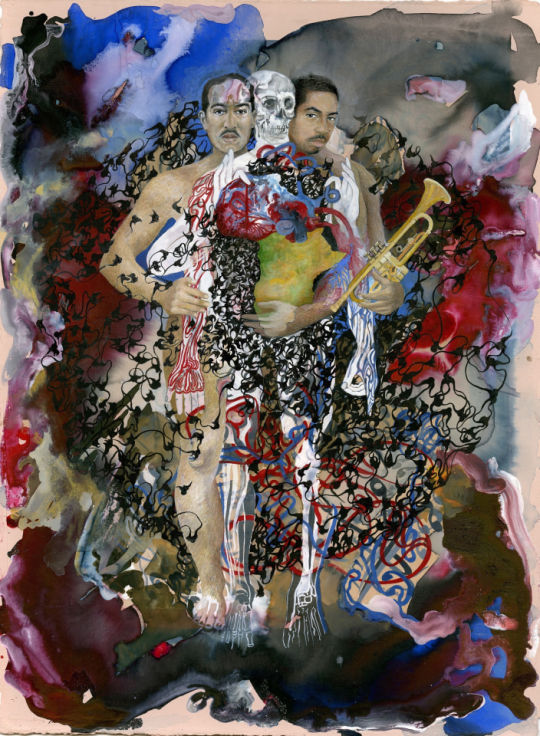
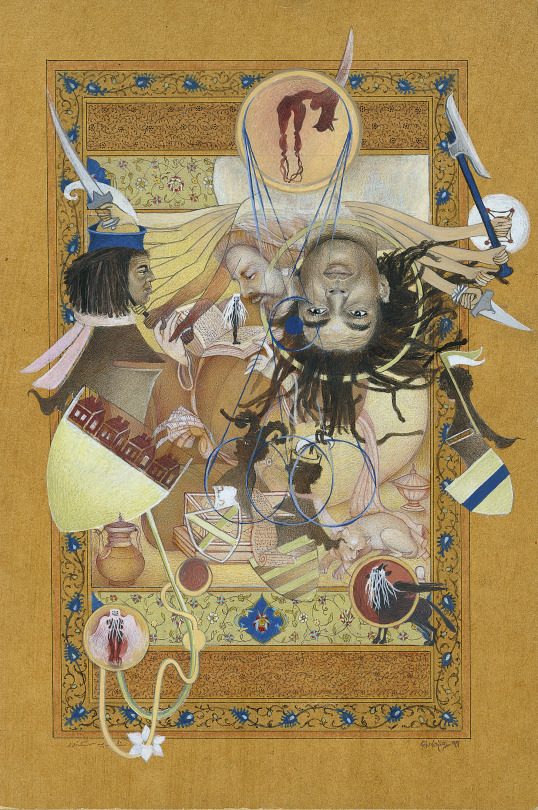
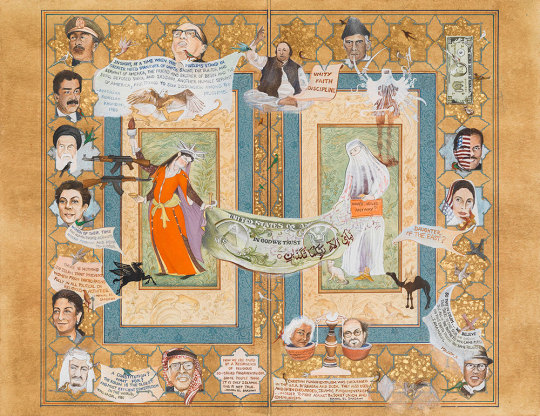
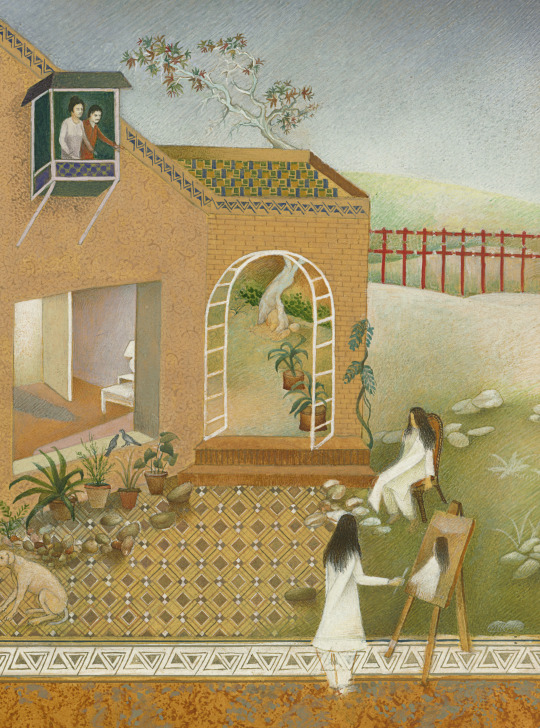
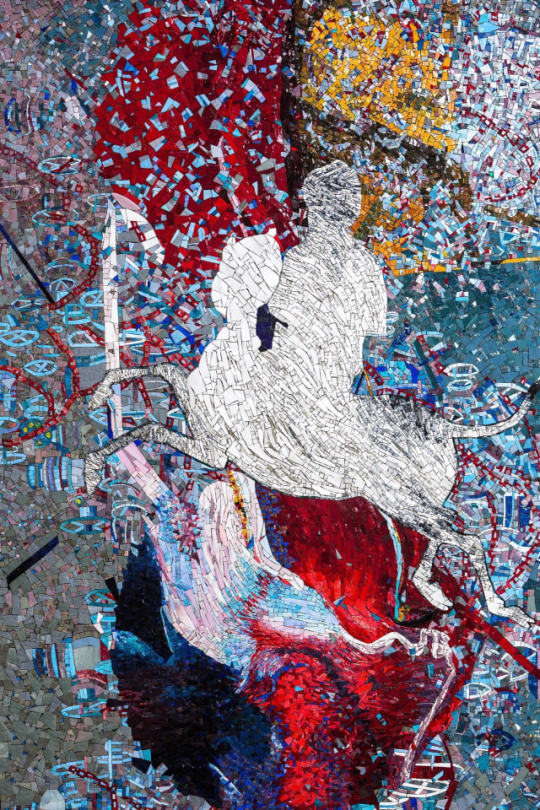
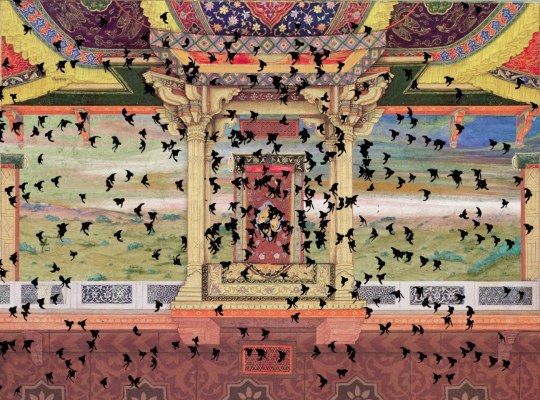
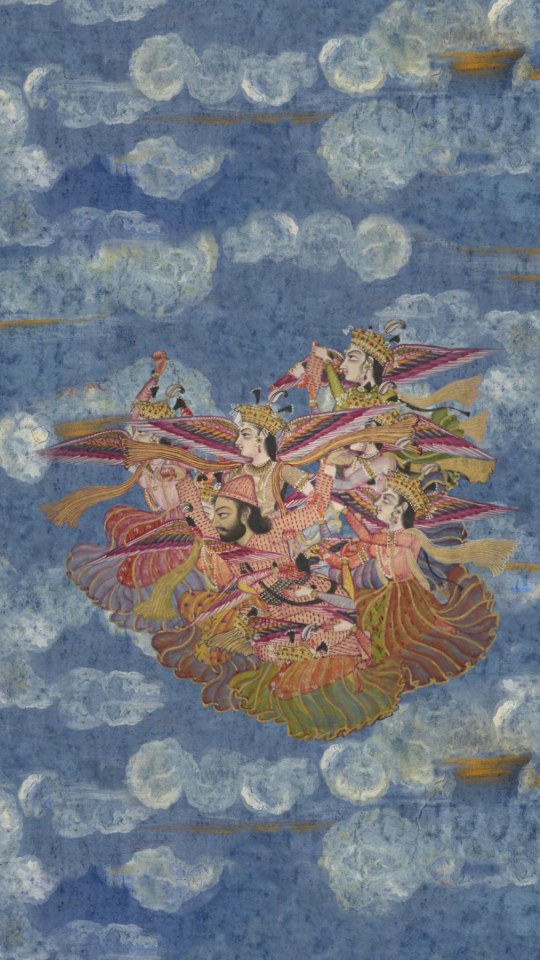
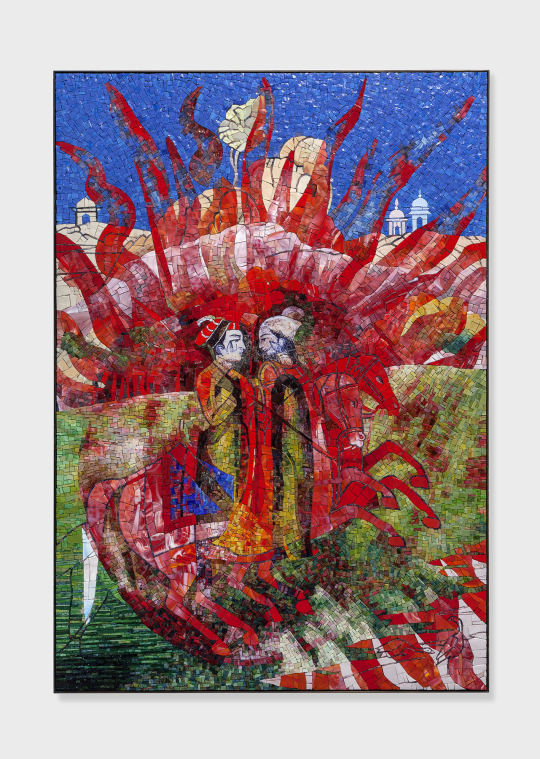
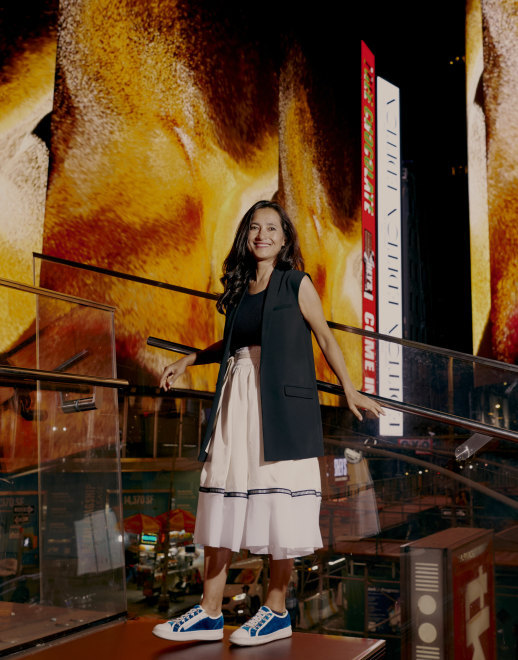
Shahzia Sikander is widely celebrated for subverting Central and South-Asian manuscript painting traditions and launching the form known today as neo-miniature. Born in Lahore, Pakistan, 1969 Sikander earned a B.F.A. in 1991 from the National College of Arts (NCA) in Lahore.
In 1997, Sikander moved to New York, where she settled and continued to experiment with interdisciplinary ideas. Her wall drawings and floor-to-ceiling installations of layered drawings, still based in her neo-miniaturist foundations, eventually morphed into multichannel video animations in collaboration with composers and musicians.
Most recently in January of 2023, Sikander was an adjunct professor for Columbia’s Institute for Comparative Literature and Society in a seminar that developed approaches to the manuscript tradition today through new practices of experiment and innovation.
https://www.morganstanley.com/.../shahzia-sikander...
21 notes
·
View notes
Video
youtube
Top Home Furniture Styles That You Can Choose
Many people read magazines to get furnishing ideas. Magazines are the best way to learn about the latest trends. However, many people avoid buying trendy furniture because, after some time, they become outdated. They, therefore, prefer their styles instead of the trendy ones. In this article, we will share some of the all-time click here favorite home furniture styles that you can choose for your home. You can find these top styles when you visit the best furniture outlets.
Traditional:
If you are having an interest in history, you should go for traditional house furniture. This kind of furniture includes timeless and classic lines and you will find it in the best furniture stores. The furniture uses fine woods and high-quality fabrics that represent traditional decorating styles. Neoclassical, English and colonial designs are popular among people who love history. Many home furniture stores offer a variety of traditional furniture from an elegant wood dining room set to leather sofas.
The furniture is available in different colors, materials, and texture. Visit the best furniture showrooms and see a broad range of traditional furniture.
Casual Style:
Comfort plays a primary role in casual decorating style furniture when you need the best furniture in Lahore. We can use this kind of furniture for both purposes like for relaxation and in the any function. This kind of furniture offers an atmosphere of relaxation, which is good for any family life. Usually, modern material like stainless steel, chrome, and vinyl is used in making casual furniture.
Contemporary style:
The most popular furnishing style is contemporary style. This style changes with time because it depends on the latest trends. The best furniture in Islamabad usually has a contemporary style. Contemporary style usually includes features derived from several other different design styles. Today the contemporary furniture style is different from the past years' style. Contemporary style furniture fits in any room easily.
Rustic Style:
This style uses raw and other natural elements. It is a very popular style in these days when you want new furniture in Lahore or Islamabad. There are many common designs such as pioneer and old styles are that use natural state wood and planks. The use of natural materials is a prominent feature of this style. Rustic style furniture’s popularity rises it spots the look of wood pieces. The furniture items are usually made of reclaimed wood and trees. Those who like nature or casual interior love to have rustic furniture styles.
Eclectic Style:
There is no rule for that kind of style. This style is made of a variety of mixed furnishing items. This kind of furnishing style has creatively paired up with different furniture pieces. Eclectic style is highly expressive and creative. A personal taste matters when you are going to choose new furniture in Islamabad. When you have furniture according to your taste then you feel happy. Every style has its importance.
2 notes
·
View notes
Note
I initially didn't think of typing out this ask, (mainly because this is a side order countdown account) but upon seeing the many pro Palestine and Palestinian awareness posts on here I decided to give 2 cents on this. I Come from India and in 1947, nearly 200 years of British rule came to an end and India was given independence. Yet, this would not be a time for celebration. Upon independence the British decided to partition the colony into 2 different countries based on religious lines, creating a Muslim pakistan and Hindu India. The new border between the countries was only revealed to the public after independence day and over 16,000,000 people were told leave the place where their ancestors had lived for centuries and cross the border to a separate country simply because of their religion. Over 15,000,000 were displaced from the partition and another 1,000,000 were murdered in cold blood and over 75,000 were raped by religious mobs who took advantage of the chaos and caused mass riots across india and pakistan. It wasn't long before the militaries of both countries stepped in and a massive undeclared war broke out in the north, killing even more people and hightening religious tensions and hatred. My grand uncle was in lahore for a buisness trip when the partition happened and my great grandmother recieved a telegraph saying that he had gone missing, 2 weeks later he was found, but he was never the same person. He never really talked about what he saw and died just a few years later. Even today, In modern day India, the repercussions of what happened in 1947 are still felt today and now with elections coming up and the increasing likelihood of the Hindu extremist government being reelected again I fear for my Muslim friends more then ever. What's happening in Gaza horrifies me in a way I can't really explain. A constant fear that has been plaguing me ever since October was that the same thing might happen here in India. Sorry if there are any typos in this, I'm literally shaking as I write this. My heart goes out to all the innocent people being bombed by Israel and I hope that a ceasefire will be signed and I hope that no people will ever have to go through what the innocent people of Palestine are going through and have been going through for the past 76 years. You don't need to respond to this if you don't want to, I just wanted to at least somewhat express my Outlook on the genocide and it's chilling resemblance to the religious holocaust that occurred in my homeland. Palestine Zindabad.
I'm so sorry for all that you've experienced, Anon.. Mourn for the dead, fight like hell for the living. 🇮🇳❤️🇵🇸
4 notes
·
View notes
Text
A dive into the archives
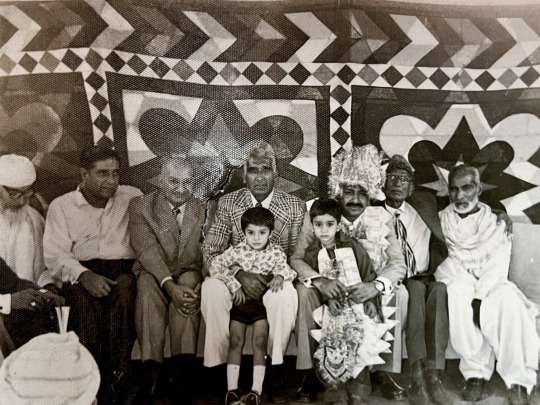
Image 1: My maternal family at a wedding Dawat in post-partition Lahore, Pakistan (1977) The groom, who happens to be my Mamoo (maternal uncle) is adorned with shiny headwear and garlands sewn with cash notes. The colourful, patterned shamiana tent veiling the Dawat is a common occurrence in banquet halls even today. Dawats also serve as the ideal opportunity to get multiple family members and kin together for a group portrait, a crucial and vital method of documenting a visual record of humans that are often overlooked and erased from history and whose lived experiences have been minimized and rendered invisible by colonial hegemonies.
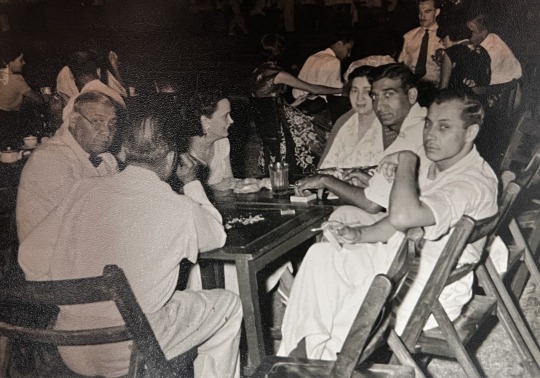
Image 2: My maternal grandfather, F.D Chaudhry, a soldier in the British Army, hosting his British and German friends at a small Dawat in post-partition Lahore, Pakistan (1950) These are foreign families that chose to remain in Pakistan after the partition of the country from India, but have since returned to their respective homelands.

Image 3: My mother, Mohtarma Rubina Magsi, celebrating Shab-e-Barat, a major Dawat for the global Muslim community, honoured in the month of Sha'ban in the Islamic calendar (1980s) After finishing our prayers in new clothes, we would head outside into the garden to play with sparklers and light little diyas (oil lamps made from clay) all around the boundary walls of our home. The deceased are honoured on this day and the festival is celebrated in unique ways in Muslim countries around the world, depending on the country and culture.
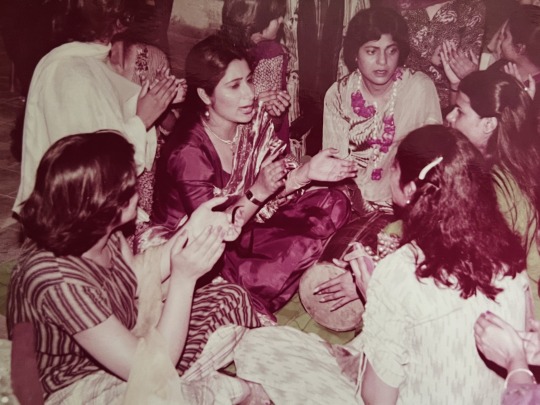
Image 4: Mohtarma Rubina Magsi surrounded by her singing and clapping women friends ( Late 1970s) They are taking turns playing the dhol (drum). Often a sturdy, silver spoon is also hit onto the center of the dhol to add depth to the music. Some guests may even reach for a dufflee (tambourine) and clap it against their henna stained palms. The music can range from orally transmitted folk songs to Bollywood hits from across the border. Healthy competition is fostered as guests attempt to outdo one another with an impressively long array of memorized songs.
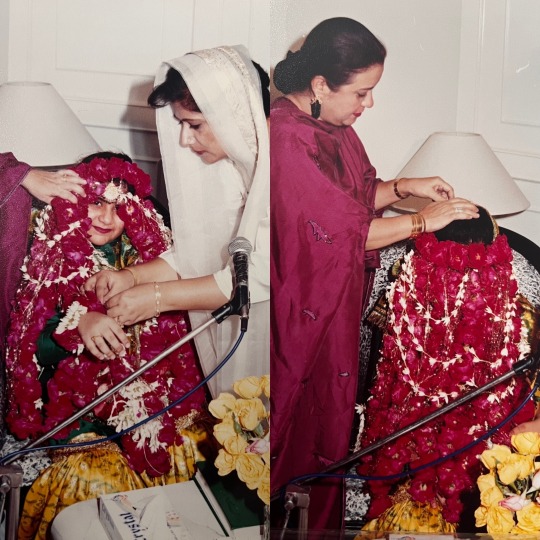
Image 5: A duo collage of community elders veiling my hair and face with heavy garlands of vibrant, red rose flowers to mark the Rasm-e-Ameen, a Dawat hosted to honour the completion of formal Quranic education. The customary prayers are followed by a large buffet style banquet feast. (1993)
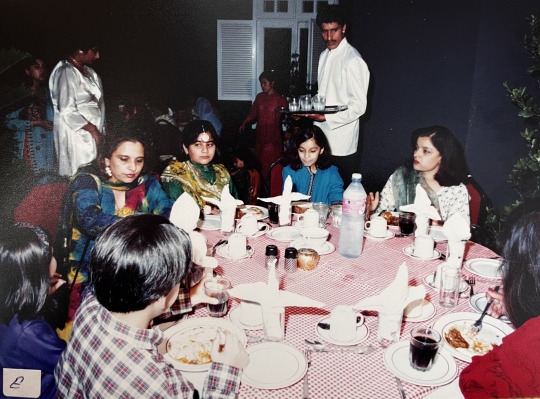
Image 6: Guests enjoying their banquet dinner on a round table after the Rasm-e-Ameen. A waiter holding a tray with glasses watches over the banquet tables to ensure the guests are looked after. (1993)
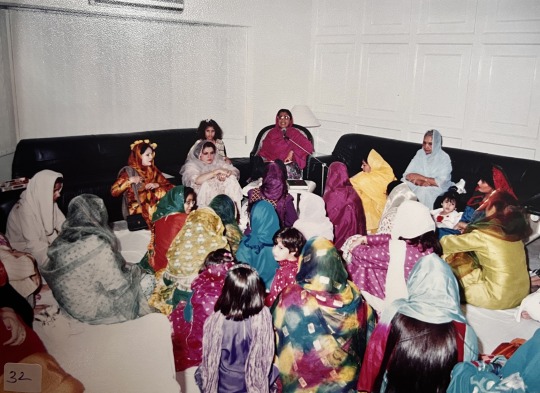
Image 7: A women prioritized Dawat-e-Milad in praise of Prophet Muhammad, hosted at our home in Karachi, Pakistan. Though veiling of the hair is not an imposition in Pakistan, even at women prioritized religious, cultural and spiritual events such as these, both Muslims and non-Muslims loosely cover their hair momentarily, out of respect. (1995)
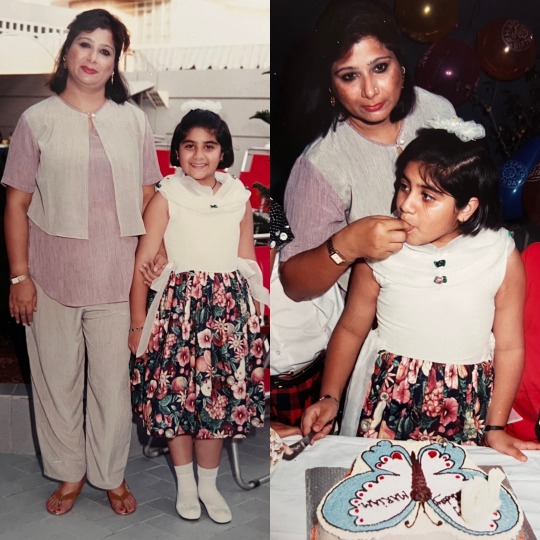
Image 8: A birthday banquet to honour the day I was born. It is interesting to note, that while traditional, cultural garments are prioritized for certain events, like the Dawat-e-Milad, Rasm-e-Ameen or a wedding Dawat, western clothing, games and food is often engaged at Dawats such as birthdays and graduations. (1994)
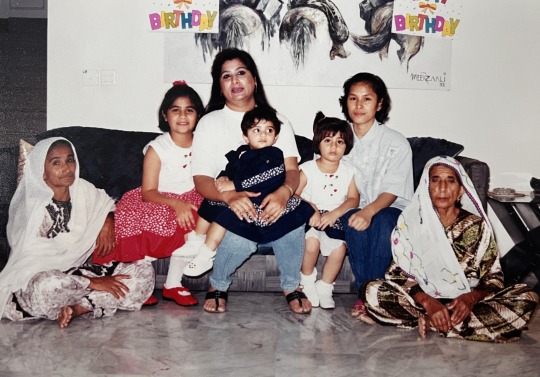
Image 9: Generation after generation, the visibility of women in documentations of family life has increased. This is a family photograph taken on my birthday Dawat (1993) with my mother at the center, surrounded by children, and caregivers from the Philippines and our ancestral lands, Jhal Magsi, Balochistan. I was truly raised by a multi-generational, diverse village of people from all corners of the world. While some members of our family are wearing western clothing, others are dressed in traditional, cultural garments and have chosen to veil their hair.
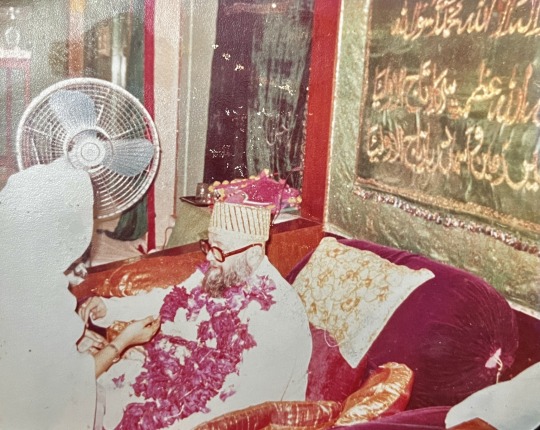
Image 9: A spiritual, Sufi Dawat at the Taji Shrine in Meva Shah, Karachi. My mother is adorning our family's Sufi saint (Baba Anwar Shah Taji) with heavy garlands of red roses. (1980) While flowers are given feminine traits in various cultures around the world, in many South and Central Asian countries, such as India, Pakistan and Nepal, flowers are a gender neutral way of showing love and adoration through the art of ornamentation. After the customary Sufi rituals are complete, the congregation gathers side by side on the floor to consumer Langar, a meal that is served to everyone in attendance, at no cost. The Langar menu can vary from week to week, consisting of curries, rice dishes, naans and sweets, and no one is turned away from the doors of the shrines when Langar is served. Whether cis or trans, male or female, able or disabled, rich or poor, local or foreign, everyone is welcome here. In some shrines the genders are segregated.
Most Dawats in Pakistan mark important life milestones, like births, birthdays, weddings, graduations and are also influenced by cultural traditions and religious rituals, varying from household to household, depending on cast, clan, socioeconomic standing, province and religion.
There are some motifs and symbols that make a recurring appearance, era after era, such as rose petals and night blooming jasmine flowers, shamiana tents, cauldrons of Biryani, unisex garlands and head coverings made with either cash or flowers (or both), various forms of veiling (with both textiles and flowers), the dhol (drum) and of course, endless cups of Chai. Of the various significant Dawats that take place throughout the year, apart from events like birthdays and weddings, certain religious Dawats like Shab-e-Baraat (a major festival for Muslims celebrated in the month of Sha'ban, the eighth month of the Islamic calendar) Rasm-e-Ameen (formal completion of Quranic education), Urs (death anniversaries of Saints and Mystics), Milad (events fostered in praise of Prophet Muhammad) and Niyaz (Meditative chanting and prayers followed by distribution of food amongst the needy) also encompass specific rituals and customs. As visible in the archives, there was also a healthy mix of retaining local, familial customs and traditions, while also engaging with clothing, games, food and rituals from cultures outside of Pakistan.
For example, every New Year’s Eve, it was customary in our home to consume a large feast of purely Filipino food, made by our caregiver, Flordeliza Sauza. Right as the clock would strike midnight, you best believe, we would be shoving Siopao, Pansit and Chicken Adobo with garlic rice into our excited, hungry mouths. Similarly, Chinese food was also a staple, especially at birthday parties and weddings. My wedding Dawat feast in Karachi included several desi Kababs, Curries and Puloas originally devised in the royal kitchens of India, but many Chinese dishes were also served, such as Chicken Manchurian, Beef Chilli, Shrimp Dumplings and Vegetable Fried Rice. This is reflective of a society that is open to global influences.
Women have been at the forefront of cultural continuity in Pakistan, as well as in the diaspora. Religiously inclined Dawats, such as the Milad and the Rasm-e-Ameen often take place in women prioritized spaces, with multi-generational guests in attendance, fostering community and togetherness. One of my favourite moments from the Milad Dawat has to do with guests being showered with delicate, soft sprinkles of rose water, while standing side by side, singing and praying in a unique moment of women's solidarity. In some Milad Dawats, guests are not only showered with droplets of Rose Water, they are also covered with petals from red roses, making the experience truly immersive and embodied.
2 notes
·
View notes
Text
Quaid e Azam Library Jobs in Lahore January 2025 Advertisement
Quaid e Azam Library Jobs in Lahore January 2025 Advertisement has been published in today The News newspaper. The Quaid-e-Azam Library in Lahore is hiring 02 Assistant Librarians (BS-16) on a 3-year contract basis. Candidates must have an M.A. in Library Science (2nd division) or a Post Graduate Diploma in Library Science (2nd division) with 5 years of relevant experience. Age limits range from…

View On WordPress
0 notes
Text
*Press Release*
*December 20*
*Punjab Government to Launch Livestock Program for Rural Women Soon: Azma Bokhari*
*"Dhee Rani Program," a key initiative of CM Punjab, will begin very soon: Azma Bokhari*
*Punjab Leads as First Province to Ban Child Marriages: Azma Bokhari*
*Media and Institutions are Pillars of National Progress and Development: Azma Bokhari*
Lahore () Punjab Information Minister Azma Bokhari has said that the Punjab government is soon introducing a livestock program for rural women. She added that the Chief Minister of Punjab’s flagship initiative, the "Dhee Rani Program," will be launched soon. Punjab is the only province to have been the first to impose a ban on child marriages.
She further remarked that abuse, chaos and arson, cannot shape the destiny of this country. In our country, news is not deemed significant unless it is "spicy." The positive role of media, along with all other institutions, is indispensable for national progress.
These remarks were made during an event where she was the chief guest at a local hotel. She highlighted that Pakistan is among the countries facing numerous challenges due to a growing population. Resources are not increasing at the same pace as the population. While many Islamic countries around the world are adopting family planning, unfortunately, discussing this topic in our country is still considered taboo.
She pointed out that everyone has their own interpretation of religion, and it is unfortunate that politicians have no time to address these critical issues. Unless we collectively discuss our problems, we cannot resolve them.
She emphasized that according to PEMRA rules, all TV channels are required to allocate 10% of their airtime to public service messages. However, no media house adheres to this rule. The Information Minister stressed that we must recognize how many women and children in our country are suffering from malnutrition.
She further added that she had drafted the Domestic Violence Bill, but she faced “fatwas” against her for it. Today, women’s health is a major issue. Raising two children is much easier than raising five. The Chief Minister of Punjab takes the topic of family planning very seriously. We are also collaborating with the federal government on this issue.
She stressed the need for everyone to come to the table and discuss family planning collectively. Through collective efforts and dialogue, we can take the country forward. No government can solve problems alone; the state must work together on this.
She also noted that our society has become so modernized that even old age homes have been established here. In Punjab, virtual police stations provide protection to women without requiring them to visit police stations. The Chief Minister of Punjab is distributing motorcycles to young girls. The goal is to elevate Pakistan’s standing and make its economy a successful one.
0 notes
Text
youtube
#rain in karachi#karachi rain#karachi rain update#street view karachi#karachi street view#moto vlog#ultra hd video#bike on rain#rain and ride#wet road#karachi tour#breaking news#how to make#karachi street view 4k#karachi street view reaction#karachi street view lahore#peoples square karachi night view food street#defence karachi street view#karachi rainy day#heavy rain in karachi today#karachi rain today#karachi rain news#caught on rear camera#Youtube
0 notes
Text
youtube
#rain in karachi#karachi rain#karachi rain update#street view karachi#karachi street view#moto vlog#ultra hd video#bike in rain#rain and ride#wet road#karachi tour#breaking news#how to make#karachi street view 4k#karachi street view reaction#karachi street view lahore#peoples square karachi night view food street#defence karachi street view#karachi rainy day#heavy rain in karachi today#karachi rain today#karachi rain news#caught on rear camera#Youtube
0 notes
Text
Consolidated Financial Reporting Software: Revolutionizing Financial Management with Cherryberrycrm
In today’s fast-paced business world, accurate and efficient financial reporting is crucial for making informed decisions. For companies with multiple departments, subsidiaries, or branches, consolidating financial data can be a complex and time-consuming task. That’s where Consolidated Financial Reporting Software steps in—offering businesses a streamlined solution to manage their financial data more efficiently. In Lahore, businesses are increasingly adopting advanced solutions like Cherryberrycrm to simplify and enhance the financial reporting process.
What is Consolidated Financial Reporting Software?
Consolidated Financial Reporting Software is a specialized tool designed to consolidate financial data from multiple sources, enabling businesses to create unified financial statements. This software allows companies to automatically aggregate financial information from different departments, subsidiaries, or geographical locations into a single, comprehensive report. The resulting consolidated financial statements are crucial for management, stakeholders, and regulatory compliance.
The main goal of this software is to provide an accurate, real-time overview of the financial health of the entire organization, without the manual errors and inefficiencies of traditional methods. It simplifies processes such as eliminating intercompany transactions, applying consistent accounting rules across the organization, and preparing reports for various stakeholders like investors, creditors, and tax authorities.

Key Benefits of Consolidated Financial Reporting Software
Time Efficiency and Automation Manual consolidation of financial data from multiple departments can take days, if not weeks. Consolidated Financial Reporting Software automates the entire process, drastically reducing the time required to generate reports. This not only increases productivity but also allows finance teams to focus on more strategic tasks.
Accuracy and Reduced Errors Manually handling large volumes of financial data increases the risk of human error. With software solutions like Cherryberrycrm, businesses can ensure that all financial data is accurately consolidated, eliminating the chances of data discrepancies. The system automatically handles complex calculations and adjustments, ensuring that the reports are error-free.
Real-time Financial Insights With consolidated financial reporting, businesses gain access to real-time data, which is critical for making timely decisions. By tracking and analyzing financial performance across all departments and subsidiaries, business leaders can identify areas of improvement and make necessary adjustments promptly.
Compliance and Regulatory Adherence Regulatory compliance is another significant advantage of using consolidated reporting software. It ensures that financial reports are aligned with local and international accounting standards, reducing the risk of non-compliance. For businesses in Lahore and around the world, adhering to tax laws and financial reporting standards is made much simpler with software like Cherryberrycrm.
Customization and Scalability Every business has unique financial reporting needs, and the software must be flexible enough to accommodate these requirements. Consolidated Financial Reporting Software, such as Cherryberrycrm, offers a high degree of customization, allowing businesses to tailor the software to their specific accounting structure and reporting preferences. Additionally, the software can scale with the business as it grows, supporting the addition of new subsidiaries, departments, or even entire business units.
Why Choose Cherryberrycrm for Consolidated Financial Reporting?
Cherryberrycrm is a cutting-edge solution that stands out in the crowded field of financial reporting software. Here’s why it is becoming the top choice for businesses in Lahore and beyond:
User-Friendly Interface One of the standout features of Cherryberrycrm is its intuitive, user-friendly interface. Even for teams with limited technical expertise, the platform offers a straightforward approach to financial reporting. This ease of use ensures that your finance team can get started quickly and start generating reports without steep learning curves.
Comprehensive Financial Tools In addition to consolidated financial reporting, Cherryberrycrm provides a suite of tools for budgeting, forecasting, and financial analysis. These tools help businesses gain deeper insights into their financial performance, enabling more accurate forecasting and better long-term planning.
Seamless Integration Cherryberrycrm integrates seamlessly with existing ERP (Enterprise Resource Planning) systems, accounting software, and other business tools. This ensures that all financial data is automatically imported and updated, minimizing manual data entry and improving overall workflow efficiency.
Multilingual and Multi-Currency Support For businesses operating in Lahore with an international presence, Cherryberrycrm supports multiple currencies and languages, making it easier to consolidate financial data from different countries and regions. This feature is especially useful for companies with global operations.
Security and Data Protection Financial data is extremely sensitive, and ensuring its security is paramount. Cherryberrycrm uses robust encryption techniques and follows strict data protection protocols to safeguard financial information. With cloud-based solutions, businesses can rest assured that their data is securely stored and easily accessible when needed.
The Future of Financial Reporting in Lahore
As businesses in Lahore continue to grow, the need for efficient financial reporting solutions will only increase. Consolidated Financial Reporting Software, like Cherryberrycrm, is helping businesses transition from traditional, error-prone processes to more streamlined, automated solutions. With real-time data, improved accuracy, and enhanced compliance, these tools are indispensable for businesses looking to stay competitive in an increasingly complex financial landscape.
As Lahore’s business environment becomes more dynamic, adopting the right financial reporting software will be key to driving long-term success. With platforms like Cherryberrycrm, organizations can not only enhance their financial transparency but also optimize their overall financial management practices.
Conclusion
In conclusion, Consolidated Financial Reporting Software in Lahore is a game-changer for businesses in Lahore, offering significant time savings, improved accuracy, and real-time insights into financial performance. By choosing Cherryberrycrm, businesses can take full advantage of these benefits while ensuring compliance with financial regulations and preparing for future growth. If you’re looking for a comprehensive, easy-to-use solution to manage your company’s finances, Cherryberrycrm is the ideal choice for you.
0 notes
Text
Rangrez
Chapter 2: From Lahore

It was just another morning in Delhi. The sun started to rise and Ram was back home, sweating like a melting snow cone. He got ready to report to the police station- when he remembered he had a duty at the railway station today.
Ram didn't understand why the authorities would give him duty at most peculiar places. It was only a comfort that the railway station was close to police barracks. But he understood that crowd and riots like this can only be handled by him. It was 7 am, and the train from Lahore has just stopped on the railway station of Delhi. Chandni chowk was a bustling market, and often the crowd made its place on the railway station. Even 7 am looked like a Sunday evening sometimes. Buying a cutting chai, he sat down on the stool, observing everyone in sight.
A sweet sound pulled Ram's attention- sounds of payal not usually heard around here. His neck whipped to the sound, to see a woman dressed like a bride from head to toe. Was she a runaway? Ram looked away, continuing on his tea and biscuit. Delhi is a sight of all the freaks and couldn't care less. Ram finished his tea and got up to pay, when a hand extended in front of him to pick a toast. He couldn't help but see the fading green lines on his wrist, as if a tattoo hardly recognizable. When Ram saw the man's face, the instant anxiety kicked an intuition in Ram- he knew who the man was. Ram soon sprinted after him, as he escaped, running to catch the member of a decoy gang who looted a whole family of the superintendent. The decoy put up a good fight, injuring Ram at places but in 10 minutes, Ram had the decoy in his hands.
On the other hand, Akhtar entered the frame of Railway station, eyes seeking for Ram. He parked his motorcycle, swinging the bag of lunch as he got off the bullet. Ammi made biryani and he had to deliver the fresh and hot delicacy. With a small smile, he made his way inside. Akhtar's first stop was the officer's room reserved for the police, but he had no luck there. Where would Ram be on such a big platform?
Upon looking further, he saw a woman, dressed like a bride from head to toe, sitting on one of the benches. Her face screamed she needed help, and she looked out of ordinary. It was almost time that she started attracting chain snatchers and ill intenders. Akhtar moved close to her, cautiously, and luckily gained her attention without calling for her.
"I am sorry to disturb but are you in trouble?"
The woman looked at him up and down, and then looked away. Akhtar gulped, but understood her ignorance. "I don't mean to do any harm, I'm just here to drop my friend's lunch. I thought you needed help." Akhtar tried, he thought. When she didn't budge from her position, he started to walk away, unsure. "Listen!" A melodious voice pulled him back, and he turned to her immediately. "I hope what you're saying is true. I am new to this city and I need a place to stay for some time." Akhtar smiled proudly "Where are you from?" "I am from Lahore, my name is Kainat"
Akhtar's eyes physically shined upon her name. "What a beautiful name, my younger sister would adore you" Kainat's eyes glistened at that. A sister who adores. "Would you know any place for me to stay temporarily?" Kainat repeated her query and Akhtar nodded, fortunately. "You can live with my family for sometime, I'm sure they won't mind" Her smile reached her eyes, nodding quickly. "Let me just find Ram Anna and introduce you to him, till then you can sit and wait in here".
Akhtar guided Kainat to the waiting room outside the police officer's room. After all, this was the safest place for her and easiest to find. She tapped her foot repetitively, anxious if she was deceived. She couldn't even get his name- all she knows is that he is looking for his friend, Ram.
About 2 minutes later, Kainat saw a man getting dragged inside the station by his collar. Must be a pick pocket, she thought, clutching her bag closer. There are a lot of them in Delhi. Kainat's attention was not on the police station, that was the last of her interest. She never understood how the people of nation could stand up against the freedom of their own family, their own blood. Whites to be damned, her blood boils whenever she witnesses a brown police officer. That was one of the things she hated about nawabs- taking the oppressor's side for their own luxury and comfort. She loved dancing, as long as it was in front of the women of Mahal and even the white oppressors. Although, were Huzoor any less than an oppressor herself?
Kainat snapped out of her thoughts when she saw someone limp and sit in front of her, his loose white shirt bloody. He huffed, closing his eyes and rested his head back. Kainat thought of him to be a culprit too, when a constable gave him a glass of water and left. Curiosity took the best of her, and she couldn't help but ask.
"Are you a police officer?" Ram opened his eyes to see the runaway bride he saw sometimes back. He closed his eyes again, nodding in no. Better to be safe than sorry. "Then why did the constable helped you just now?" Kainat missed the small smile on his face. "I caught a criminal on the run." Ram only heard the movement of her jewellery, shuffling. "Does it hurt?" Ram opened his eyes again. He never really thought about it, he was just tired. He took a quick glance at his wounds, which were really minor compared to his other incidents. "I'd be fine" he muttered, closing his eyes again.
"Anna!" Ram opened his eyes again when Akhtar called out for him, only to be caught off guard by blood on Ram. Kainat saw Akhtar run to the bench, asking what happened. Ram calmly put hand up, asking him to calm down. Kainat couldn't help but smile at the odd duo. "What are you smiling at?" Ram's question drew a silence on Akhtar. "Do you know each other?" Akhtar asked. Kainat looked from Ram to Akhtar. "We just met now" Kainat said.
Ram finally looked at Kainat from up to down. She looked like she belonged to royalty, with a bright and innocent face, sharp eyes and plump lips. She looked like she would bring trouble. "Anna, this is Kainat from Lahore. She'll be living with our family for awhile."
______________________________________
"Kainat" Ram muttered to himself.
Tagging: @vijayasena @ramayantika @jkdaddy01 @definitelyhim @yehsahihai @starlight-1010 @lilliebeingdelulu @panikk-attackkk @multifandom-boss-bitch
#ghungru#ram charan#rrr#rrr movie#desi tag#fanfic#ram x reader#ram x wife!reader#rambheem#sanjay leela bhansali#heeramandi#rangrez
37 notes
·
View notes